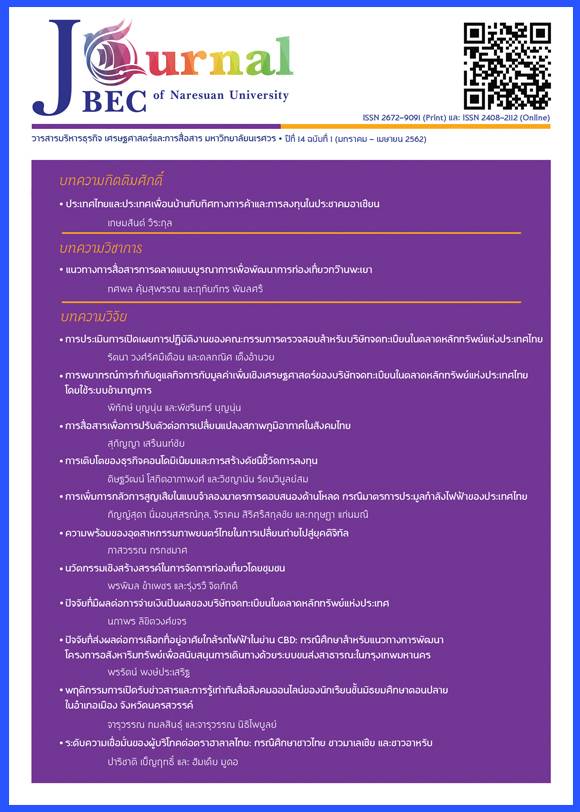การสื่อสารเพื่อการปรับตัวต่อการเปลี่ยนแปลงสภาพภูมิอากาศในสังคมไทย
Main Article Content
บทคัดย่อ
การวิจัยนี้มีวัตถุประสงค์เพื่อวิเคราะห์และสังเคราะห์องค์ความรู้การสื่อสารเพื่อการปรับตัวต่อการเปลี่ยนแปลงสภาพภูมิอากาศในสังคมไทย รวมถึงแสวงหากรอบความคิดและเสนอกลวิธีการสื่อสารเพื่อการปรับตัวที่เหมาะสมกับบริบทสังคมไทย ดำเนินการวิจัยด้วยระเบียบวิธีวิจัยเชิงคุณภาพ ได้แก่ การวิจัยเอกสาร สัมภาษณ์เชิงลึกผู้เกี่ยวข้อง และสังเกตการณ์แบบไม่มีส่วนร่วมชุมชนที่มีการปรับตัว ผลการวิจัยที่สำคัญพบว่า กรอบความคิดการสื่อสารการปรับตัวที่เหมาะสมกับบริบทสังคมไทย คือ กรอบปัญหา-แนวทางแก้ไข ประกอบด้วย 9 ขั้นตอน คือ 1) ระบุประเด็นสื่อสาร 2) ระบุข้อมูลเกี่ยวข้อง 3) กำหนดกลุ่มเป้าหมายในการสื่อสาร 4) หารือกับผู้เกี่ยวข้อง 5) ประเมินแนวทางการสื่อสาร 6) ออกแบบการสื่อสาร 7) ปฏิบัติการสื่อสาร 8) ติดตามผลการสื่อสาร และ 9) ประเมินผลการสื่อสาร ผู้ส่งสารควรเข้าใจวิถีชาวบ้าน มีประสบการณ์การทำงานพัฒนาชุมชน เริ่มประเด็นการสื่อสารจากสิ่งที่ชาวบ้านคุ้นเคยอยู่แล้ว เลือกใช้สื่อได้หลากหลายตามบริบทการสื่อสารของชุมชน สร้างความรู้สึกเป็นเจ้าของข้อมูลร่วมกันและเห็นประโยชน์ที่จะได้รับ เน้นกระบวนการสื่อสารแบบปรึกษาหารือเพื่อให้เกิดความเข้าใจร่วมกันถึงความเสี่ยง วัตถุประสงค์การปรับตัว และแนวทางดำเนินการรวมถึงให้ความสำคัญกับการมีส่วนร่วมของคนในชุมชน
Article Details
เอกสารอ้างอิง
2. Chokriensukchai, K. (2016). Information exposure and the need of activities which associated with the Thai Cultural Universals of the Laos. Journal of Business, Economics and Communications, 11(1), 138-150.
3. Glass, E., Ballantyne, A. G., Neseta, T., Linner, B., Navarraa, C., Johansson, J., et al. (2015). Facilitating climate change adaptation through communication: Insights from the development of a visualization tool. Energy Research and Social Science, 10, 57-61.
4. Kasemsap, C., Panichakarn, M. and Bilmanoch, S. (2012). Vulnerability, risk communication and adaptation of agriculture in water management on climate change: Case study Bangnampriao district, Chachoengsao province. Bangkok: The Thailand Research Fund (TRF).
5. Moser, S. C. (2014). Communicating adaptation to climate change: The art and science of public engagement when climate change comes home. WIREs Climate Change, 1(1), 1-22.
6. Nisbet, M. C. (2009). Communicating climate change: Why frames matter for public engagement. Environment, 51(2), 12–23.
7. Panyakul, V. (2013). How to adapt to climate change: Lessons-learned from four partners and policy recommendations. Bangkok: Oxfam.
8. Prompitak, P. (2015). How people make a decision for environment?. Bangkok: So Paiboon.
9. Roberts, D. (2008). Thinking globally, acting locally—institutionalizing climate change at the local government level in Durban, South Africa. Environment and Urbanization, 20, 521-537.
10. Sereenonchai, S. (2014). Climate change communication: Communicating adaptation of local communities in Thailand. Doctoral thesis, Ph.D., Institute of Communication Studies Communication University of China, Beijing, P.R.China.
11. Tantrakarnapa, K. and Kliengchuay Wissanupong. (2015). Adaptation to climate change by local culture and tradition. Journal of Liberal Arts Maejo University, 3(1), 121-138.
12. Wirth, V., Prutsch, A. and Grothmann, T. (2014). Communicating climate change adaptation. State of the art and lessons learned from ten OECD countries. GAIA, 23(1), 30-39.
13. Young, C. (2014). The problem solution framework: Process guidance for adaptation practitioners. Retrieved December 11, 2016, from http://vises.org.au/documents/2015_Young_Problem_Solution_Framework.pdf


